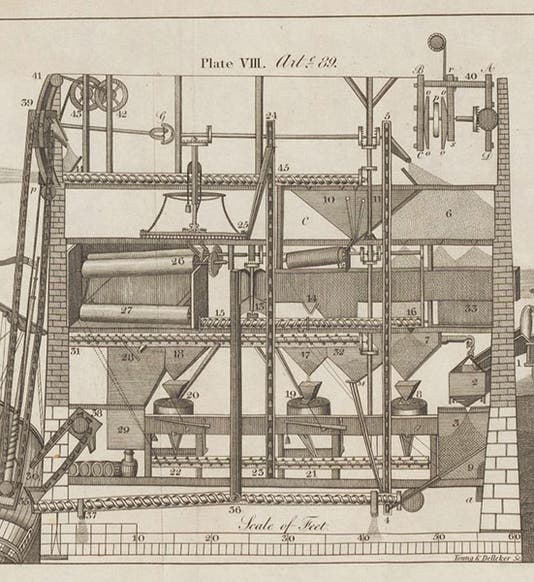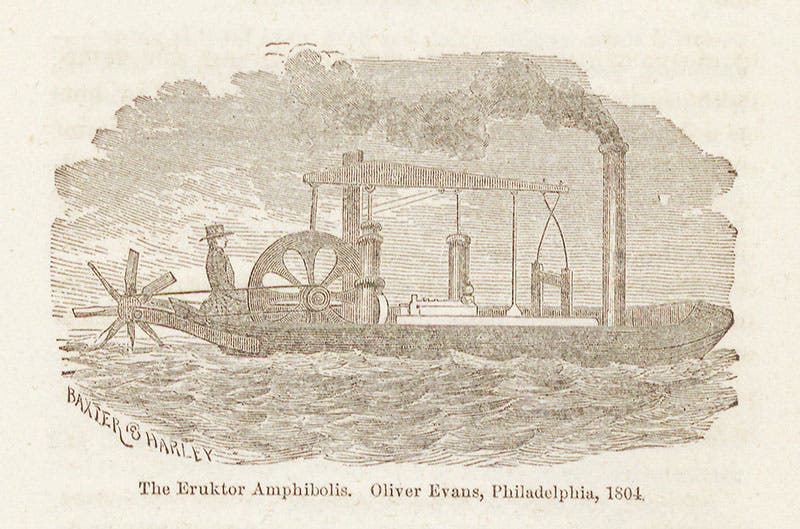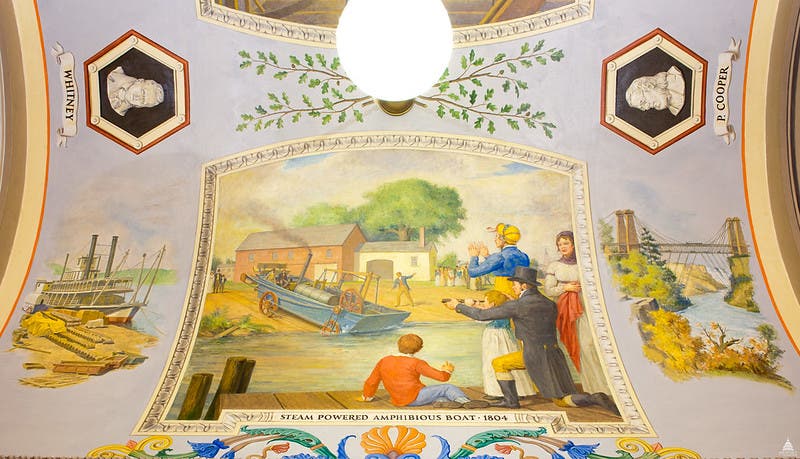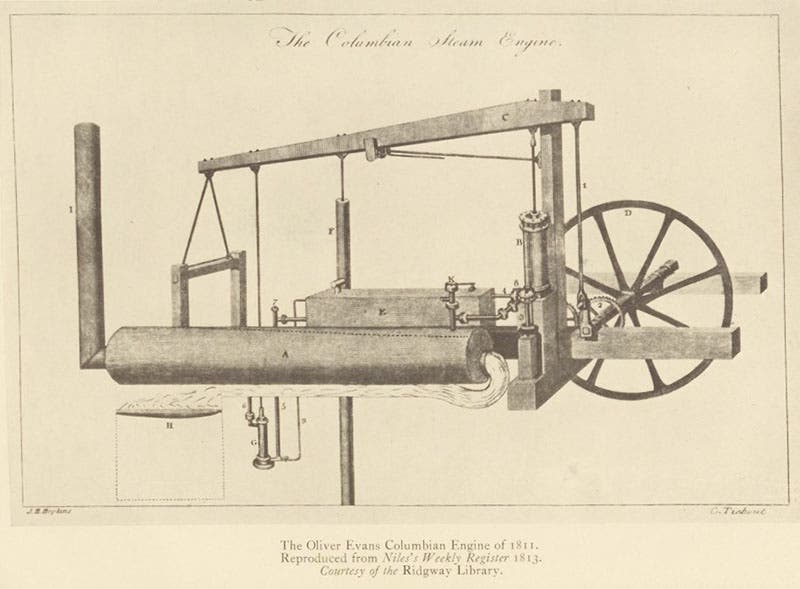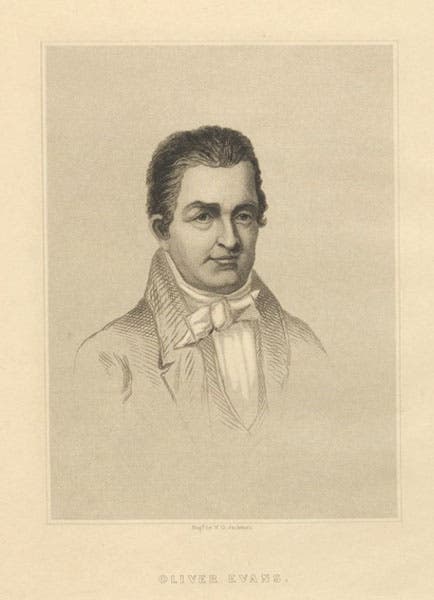Scientist of the Day - Oliver Evans
Oliver Evans, an American mechanic and inventor, was born in Delaware on Sep. 13, 1755. Evans first came to prominence when he designed and constructed a fully automatic flour mill. Using bucket conveyor belts, Archimedean screws, rotating stirrers, and a variety of hoppers, his mill was able to receive grain, raise it to the top of the mill, distribute it to the milling machinery, grind it to different degrees of fineness, spread and dry the grain, and then package and distribute it, all without human intervention, except to turn the machinery off and on and make repairs when necessary. The entire mill was driven by a waterwheel. He received a patent for his automated mill (the third U.S. patent ever granted, signed by Thomas Jefferson, but lost in the patent office fire of 1836), and his brothers implemented his design in their mills on Red Clay Creek in Delaware.
The idea of an automated mill, and of continuous production of a product, was slow to take hold, but it did so eventually and was a principal driving force for the American industrial revolution, although Evans had difficulty enforcing his patent rights. Evans wrote a book, The Young Mill-Wright and Miller's Guide (1795) which described and illustrated his automated mill with many detailed engravings, including a fold-out engraving that shows the entire mill in operation (first image). This book was often reprinted and enlarged; we have four editions in our library, but not the first; the image is from the 1826 edition. That engraving of the complete mill is often reproduced; we include here another engraving of a more sophisticated automated flour mill, seldom reproduced, which was not included in the 1795 edition, and thus must reflect later developments by Evans (second image).
Evans then became interested in steam power, especially in using steam to propel boats and vehicles. Since the Boulton-Watt low-pressure steam engine was too massive to put on a boat or in a wagon, and did not produce enough power anyway, Evans devoted his time and energy to developing high-pressure steam engines. He worked in parallel with Richard Trevithick in England, although the two do not seem to have known of each other’s work. Evans’ best known effort in the realm of steam power was his Oruktor Amphibolis (amphibious digger), a steam-powered dredge that he built for the city of Philadelphia and launched in 1805. It is described as an amphibious vehicle, but as far as I can tell, the only reason it had wheels on it was to get it to the water, since it weighed in at 17 tons. It was only marginally successful as a steam dredge, paddling around Philadelphia on the Schuylkill River, before being dismantled in 1808, but it became better known as the years went on, especially after Evans' death in 1819. Wood engravings of the Oruktor were included in nearly every history of steam power from 1830 on, when such histories started to be written; we show one from 1857 (third image). A mural of the launch of the Oruktor was even included in the Great Experiment Hall in the U. S. Capitol Building, painted by Allyn Cox in 1973-73 (fourth image).
Most of these illustrations of the Oruktor, including the mural, are unlikely reconstructions – certainly the bicycle-like wheels in some depictions would never have supported the weight of Evans’ craft. And none of the illustrations depicts the principal purpose of the craft, to dredge up silt and debris from the river bottom with a conveyor belt of buckets powered by the steam engine. Evans published a second book in 1805, The Young Steam Engineer’s Guide, but although he discussed his Oruktor briefly, there is no illustration. We have what is described as a first edition of this book in the library, but as there is no publication date in the book, we need to verify this.
Evans kept working on high-pressure steam engines and started a factory in Philadelphia, the Mars Works, to supply high-pressure engines for all sorts of manufacturing purposes. By 1812, he had developed what was called the Columbian steam engine, which seems to have been a success, although Evans himself never again tried to put a steam engine in a boat or road vehicle. But he set up another factory in Pittsburgh and made steam engines for steamboats built by others. Evans spent most of the last ten years of his life trying to enforce his various patents with roving squads that looked for patent violations, pursuing countless lawsuits, and becoming very unpopular in the process. But there seems little doubt that he deserves as much credit as anyone for powering up the industrial revolution in America.
In 1935, Greville and Dorothy Bathe published a thick quarto volume, Oliver Evans: A Chronicle of Early American Engineering, which contains all the documentary information available on Evans and reproduces scores of illustrations from all sorts or original sources that are impossible to find in most libraries. I don't know anything about the Bathes, but this book was clearly a labor of love. Our portrait is taken from the frontispiece of their book, as is the illustration of the Columbian engine.
Dr. William B. Ashworth, Jr., Consultant for the History of Science, Linda Hall Library and Associate Professor emeritus, Department of History, University of Missouri-Kansas City. Comments or corrections are welcome; please direct to ashworthw@umkc.edu.

